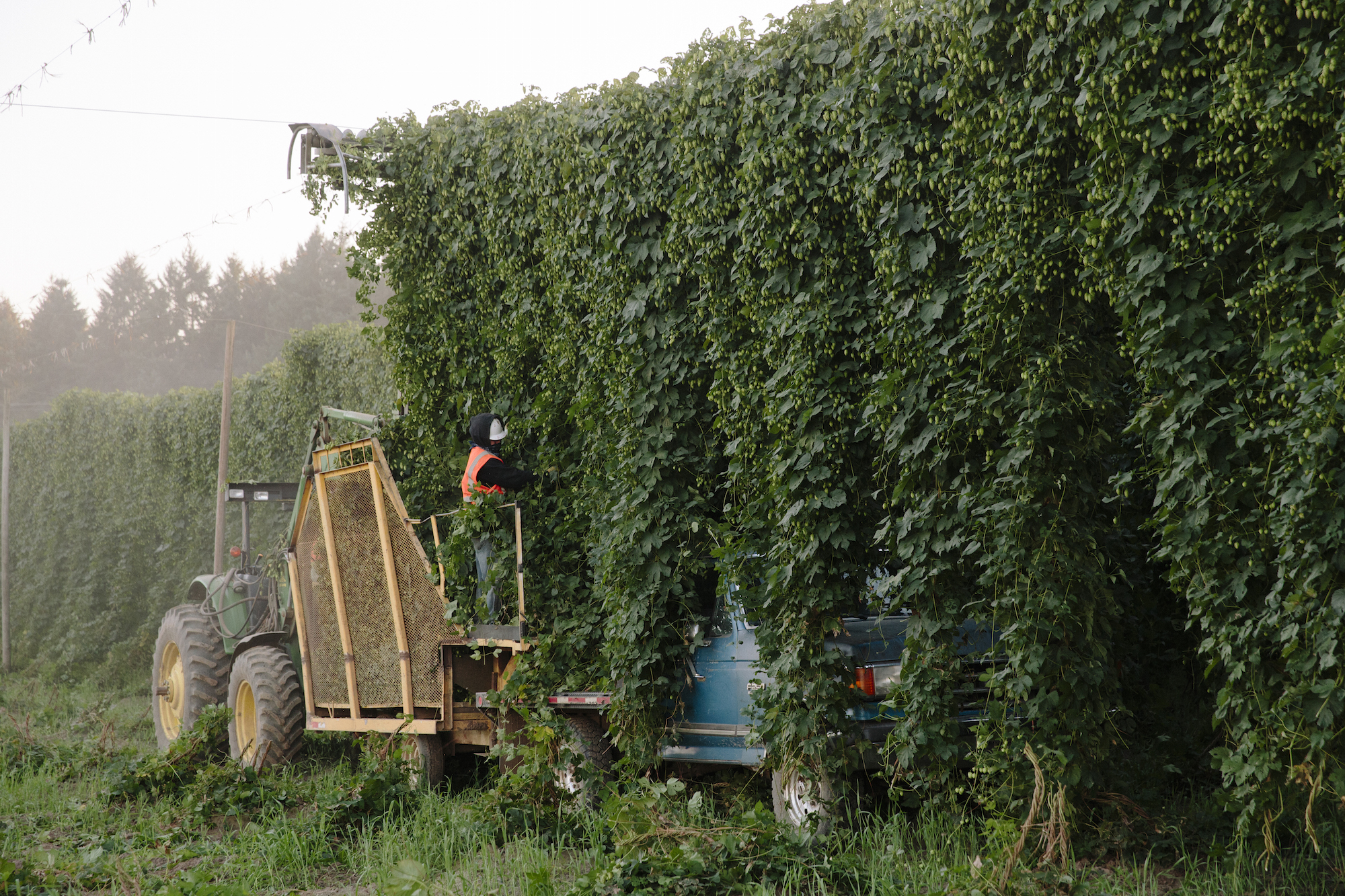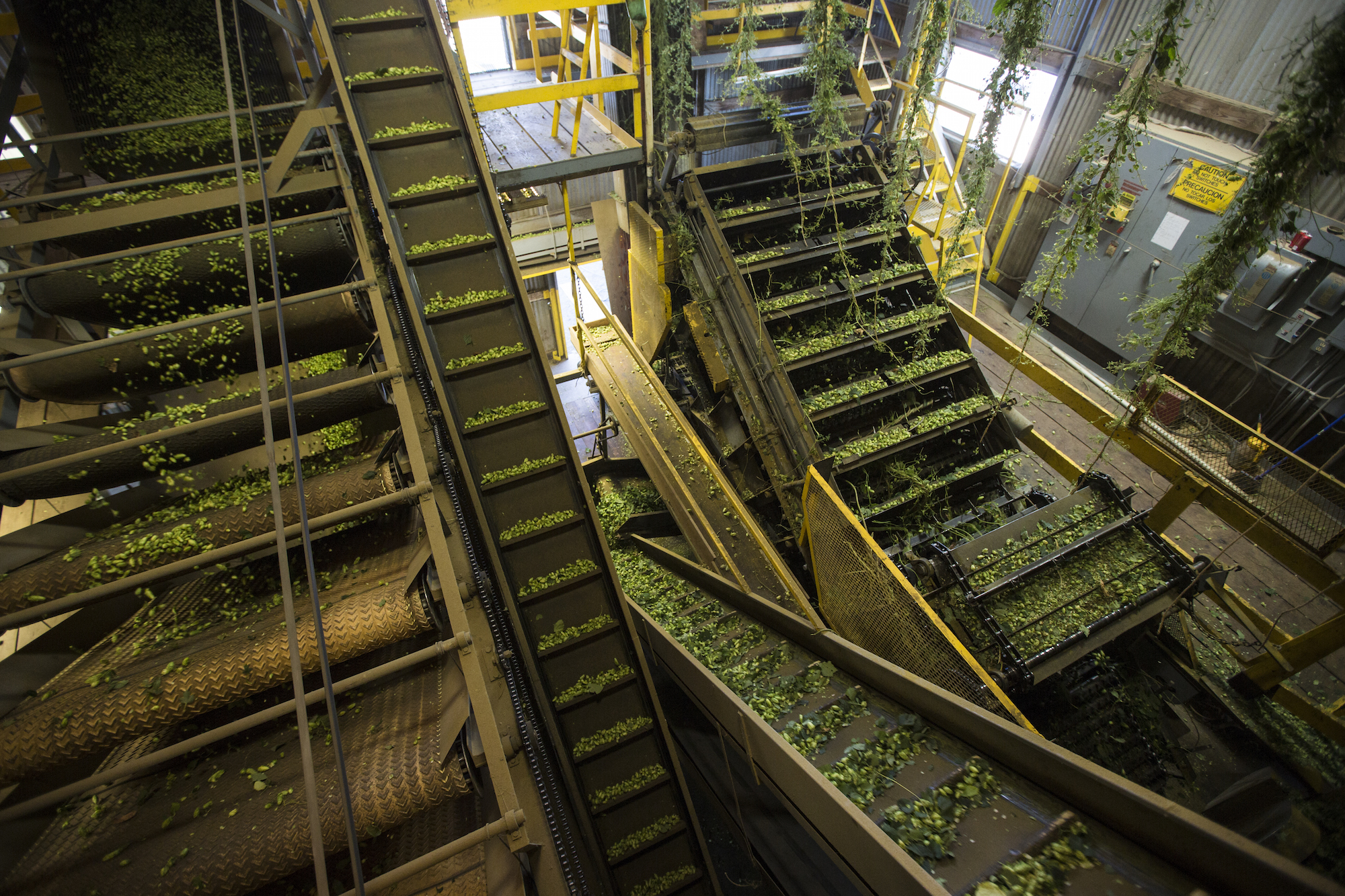
(Photo: hop harvest; care of Crosby Hop Farm, LLC)
This article was originally published in JBT #32, the autumn 2017 edition.
If you’re drinking a Japanese wet hop ale as you read this, consider yourself one of the lucky few. They are quite uncommon in Japan, and the breweries making them do a very respectable job of the style. We suspect you may see more of them, though.
Also called fresh hop or harvest ales, these beers come brewed with freshly picked hops. They begin appearing in the late summer through autumn in the Northern Hemisphere, shortly after the hop harvest commences. In the booming craft beer industry of the U.S., they are relatively easy to find at taprooms, especially near hop regions like the Pacific Northwest. With Southern Hemisphere hops from Australia and New Zealand, for example, there’s naturally a six month difference in their release.
Brewers typically use hops that have been dried to a relatively low moisture percentage (10% or less) in special kilning rooms that hop suppliers operate. Hop suppliers pelletize the dried hops or leave them in “whole leaf” (or “whole flower”) form before packaging them. This process, along with proper cold storage, preserves hops for future use.
Freshly picked hops have a much higher moisture content (close to 80%, hence the “wet” nomenclature) and are rather volatile. Fresh hops begin to deteriorate rapidly if not used (or processed) within about a day–and nobody wants rotten hops in their beer. Conversely, that freshness window ensures that the oils and other compounds naturally occurring in hops are intact and intense. These are what brewers are hoping to leverage to impart flavor and aroma. The results in a fresh hop ale are noticeably different from a beer that uses typically processed hops.
There are challenges on both the brewing and the logistics side. Brewers have to use The Force (or their senses) when brewing. Hop suppliers almost always provide at least an alpha acid measurement from a laboratory for any given hop field–the “AA” reading alerts brewers to bitterness levels. Often, they get can a detailed “crop report” with specific information about a hop’s various oil levels. But there’s no time for this with fresh hops. Brewers get what they get. They have to evaluate the hops by rubbing them together in their hands, sniffing them and using their best guess as to adequate amounts. This is why each year’s wet hop ale tastes different. This is also why brewers typically use wet hops in pale ales or IPAs; a swing in bitterness will not affect these styles as much as other styles that call for mild to no bitterness.
Brewers also have to be ready to brew on any given day. They can’t schedule a wet hop brew like a normal beer where they can just go get processed hops from their cold storage. Farmers monitor the hops and when they are in peak condition, they begin harvesting. They can’t exactly delay optimum harvest to suit a brewer’s schedule. Mother Nature waits for nobody! The brewer has to be ready to accept and use the hops–again, roughly within a day–when the hops are ready. Farmers of course stay in touch with brewers to alert them of the crop conditions, much like forecasters monitor sakura blossoms, so it’s usually not a total guessing game or surprise when the hops are ready. Unless Mother Nature suddenly imposes herself, shifting the harvest window…
The deliberate practice of wet-hopping to introduce the fresh, unusual aromas into a beer is actually quite modern. For centuries, brewers have been using dried hops, though almost certainly the use of fresh hops ‘happened’ during pre-modern times. It took some modern hop geeks to consciously realize, ‘Hey, if we put some wet hops in a beer, won’t that be intense!?’ A key turning point was probably when Sierra Nevada brewed its first wet-hop ale in 1996. The head brewer at the time, Steve Dresler (who recently retired), admits that he heard through a friend about brewers in England doing it on a small scale for festivals. That first batch, which Sierra Nevada called “Harvest Ale”, was quite sensational. Each year, Sierra Nevada increased its production (and the amount of hops it used) to meet demand, and other breweries quickly followed their lead.
One person that was there during those early years was none other than Scott Brimmer, of Brimmer Brewing in Kawasaki. As we reported in our feature about the brewery (JBT #19), Brimmer started out at Sierra Nevada as a bartender before eventually becoming an assistant brewer for many years.
Brimmers recounts, “I was lucky enough to see the madness as a bartender on the serving side as well as a brewer on the production side. As a bartender, regulars and Harvest Ale enthusiasts always asked when the hops would be arriving. Then the questions were about how the brew progressed and when it would be released. There were some serious fanatics out there. Sierra Nevada is known for its consistency, but Harvest Ale is one of those beers that would be slightly different from year to year–that made people excited. During my first Harvest Ale as a brewer, the hops arrived before the sun came up and the room was stuffed with freshly picked hops that were sent from Washington state within 24 hours of being picked. It was all Cascade on one side of the room and Centennial on the other. Part of my job was to stuff hops in large buckets to be used in the brew. I got so caught up in the moment that I started stuffing without gloves; after a while, my hands were covered in the sticky hop resin to the point of pain. It lasted the rest of the day, but was worth it for the reward. As brewers, we always anticipated the wet hop brew day with both excitement and anxiety. The increased volume of fresh hops also means that you have to be at the hop strainer to potentially physically help–there are so many hops you have to make sure the strainer can handle the load. During the day, employees from every department visit the brewhouse to check out the progress. Looking back, it was an honor to have been a part of that–brewer memories to last a lifetime.”
Two powerhouse breweries in Japan that have been doing wet hop beers in this spirit are Shiga Kogen and Baird Beer. Shiga Kogen has its own lush hop fields from which it harvests and uses wet hops, drying whatever it can’t immediately use for later brews. Baird is also developing its own hop fields at its brewery, but this year trucked in overnight some Cascade and Centennial hops from a grower in Yamagata. The beer, 2017 Harvest Yamagata Wet Hop Ale, appears in October. Last year, it did a series of wet hop ales, including one using Shinshu Wase, a native Japanese variety. There are a handful of breweries, actually, cultivating hop fields, and some are using wet hops on a very small, experimental scale. Most breweries do not have land to cultivate hops, much less the time and human resources. They buy their hop supply from brokers that import it already processed.
Perhaps the biggest restraint in Japan is the lack of more independent, commercial hop fields. The ones of considerable size in Japan are managed by industrial breweries, mostly for their own research and use. There is a hopyard in Kyoto prefecture’s town of Yosano now that began trials with brewers a couple of years ago, but it is relatively small and still getting established. It seems likely that more demand for fresh hops, however, could convince other farmers to start cultivating it.
It’s worth noting here Kirin’s interesting pioneering status in this context. Kirin manages a sizeable hop farm in Tono, Iwate prefecture, and as early as 1999 has been brewing a “freshly picked hop” beer (Ichiban Shibori Toretate Hop)–rather bold and impressive for an industrial brewery at the time. However, to overcome the logistical nightmare of getting so many fresh hops to their brewery before deterioration, Kirin has been freezing the hops. Some craft breweries in Japan that are making “fresh hop beers” followed in those footsteps, having newly picked hops frozen until they are able to brew with them.
Kirin and the handful of Japanese breweries using this technique are not alone. There are a couple of other breweries in America quietly doing the same. Breakside Brewing in Portland, Oregon, in fact, uses liquid nitrogen to break apart the fresh hops shortly before brewing. A few other breweries have called them out, but Breakside argues that this still enables them to harness the unique qualities of fresh hops. Something else we considered is that breweries have often embraced new technologies at the expense of older ways of doing things. Maybe freezing is just a technological advance.
There’s an obvious controversy here. Do you consider frozen vegetables “fresh vegetables”? Most people don’t, and hops are basically like a vegetable. Yet, we’ve seen no research that indicates freezing diminishes the quality of freshly picked hops. We’re absolutely not suggesting that “fresh hop” beers using some kind of freeze method are inferior in quality. We are noting that you should be conscious of the differences in understanding. Most brewers and consumers in North America, England, New Zealand and Australia (hop cultivation regions where wet hop beers are not uncommon) understand “wet hop” or “fresh hop” beer to mean the practice of brewing within 24 hours or so of harvesting, as described above.
Now to make the story even murkier… The Great American Beer Festival competition style guidelines clearly say that “wet hop” or “fresh hop” ales may contain kilned/dried hops. Which are the exact opposite. If you kiln (dry) hops, they are neither wet nor fresh. This makes no sense. It seemed completely contradictory until we looked into it more deeply. The guidelines would allow for a brewery to add some amount of dried/kilned hops to a recipe that was mostly fresh/wet hops… like a kind of hybrid. There are at least a couple American breweries that do this. The GABF guidelines are written in a way that would accommodate this. The problem is that it doesn’t specify how much dried/kilned hops is too much. Again, the vast majority of breweries don’t practice this, but Breakside unsurprisingly noted that if this is allowed, why shouldn’t freezing fresh hops be.
We think transparency solves a lot of the problem. It would be helpful and interesting if breweries revealed what tradition or method they followed. Then let the beer speak for itself. Let consumers decide. Wouldn’t it be fun for them to try beer made with the various methods to see if they can discern differences? (It would be educational for brewers, too). And if they are excited about this, it just means more demand for fresh hop beers. Which in turn means more encouragement for independent hop farms. As this edition of Japan Beer Times comes out, there should be a small fresh hop festival underway. About a dozen bars across Japan will be serving fresh hop beers from nearly 20 breweries. Seek them out and ask breweries more about them if you like what you drink.
(photo: processing hops; care of Crosby Hop Farm, LLC)

This article was published in Japan Beer Times # () and is among the limited content available online. Order your copy through our online shop or download the digital version from the iTunes store to access the full contents of this issue.



